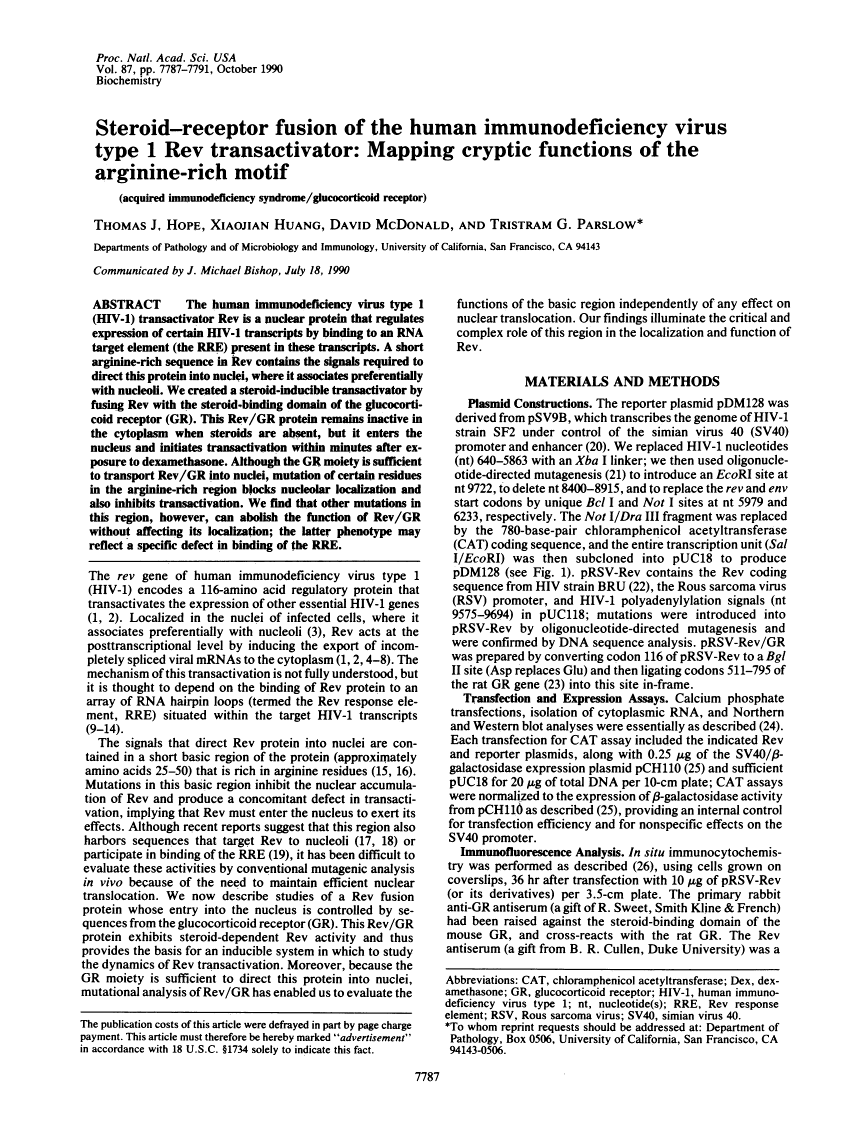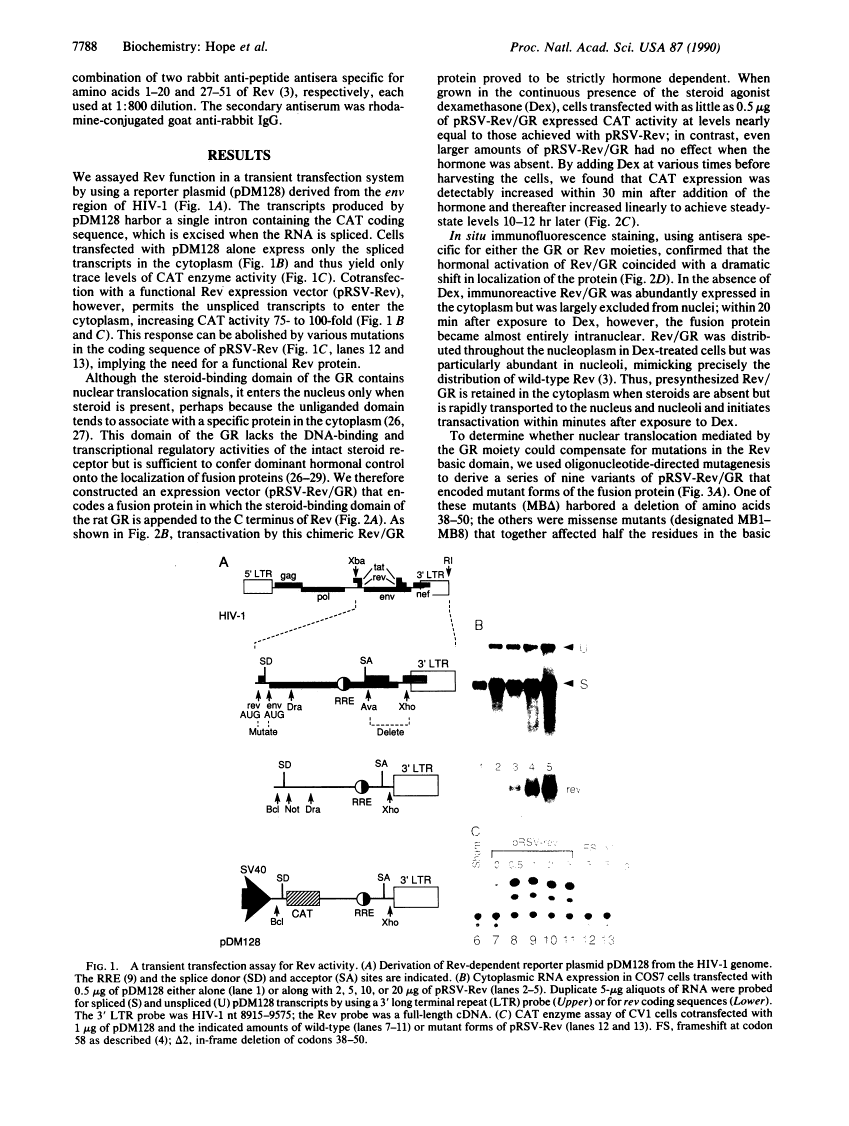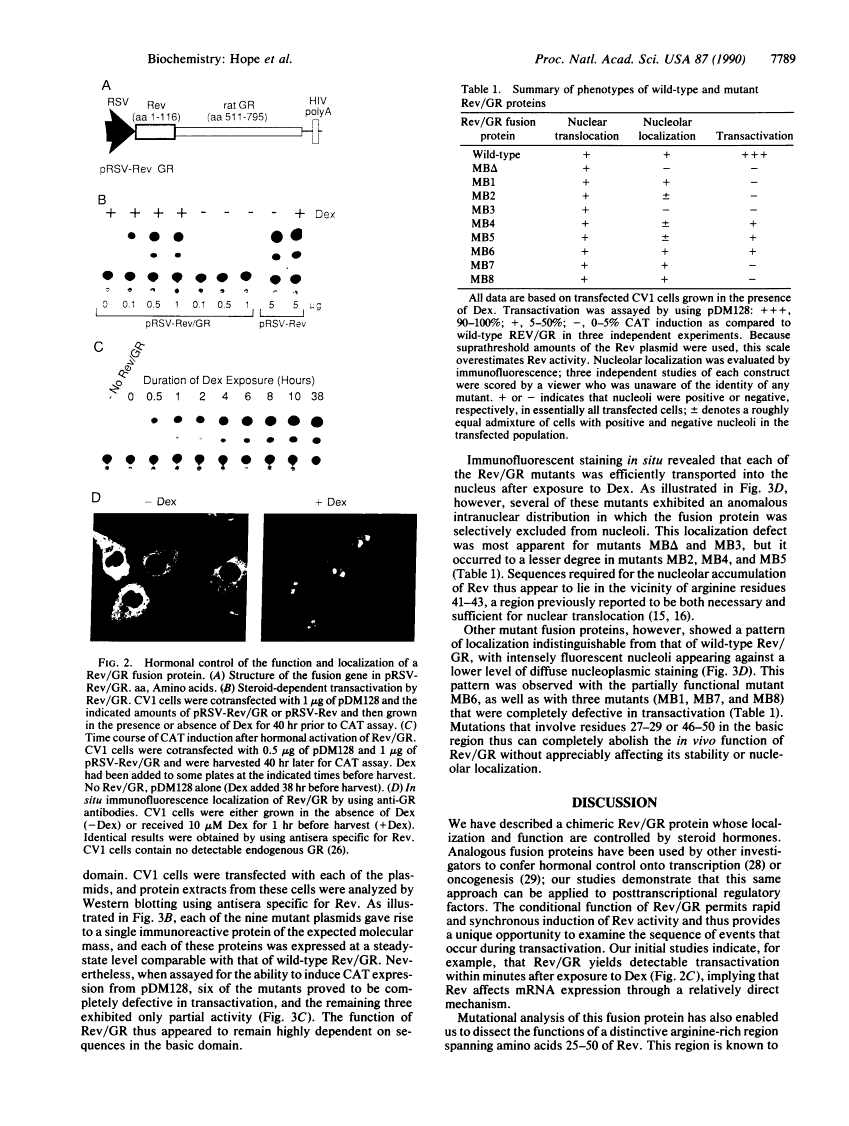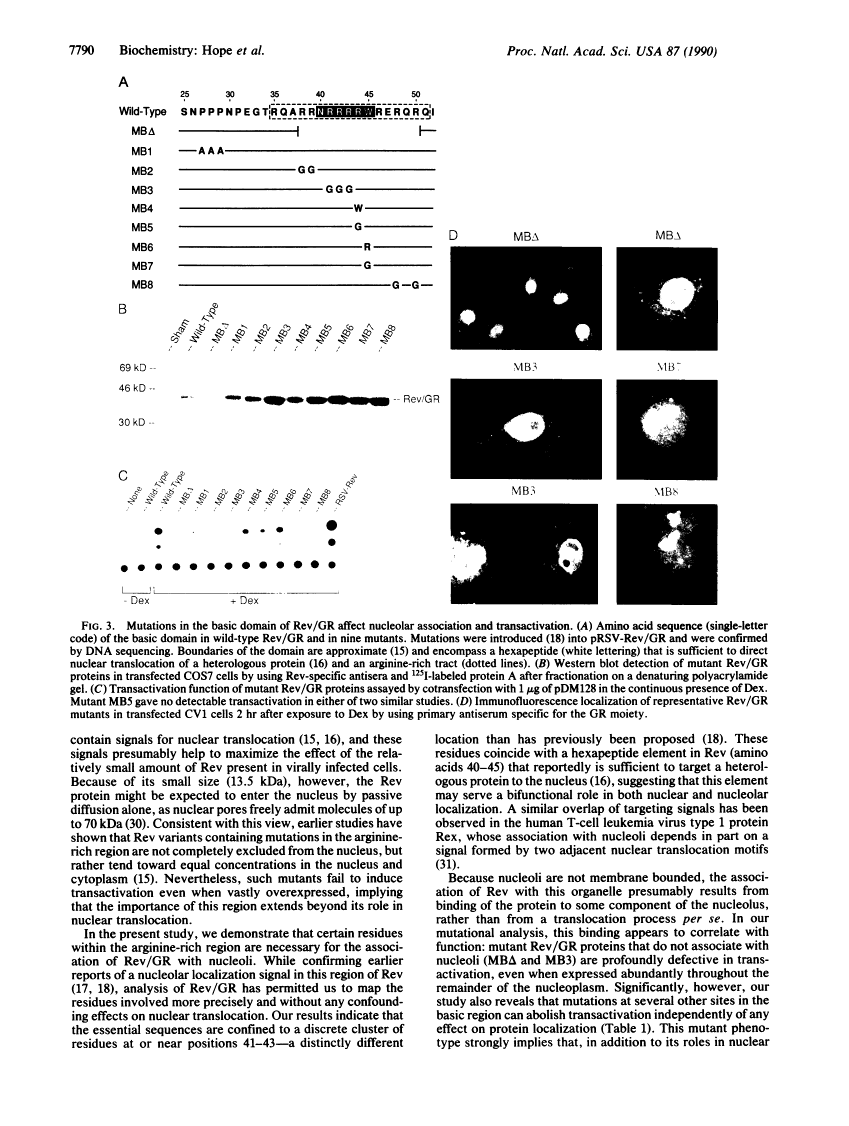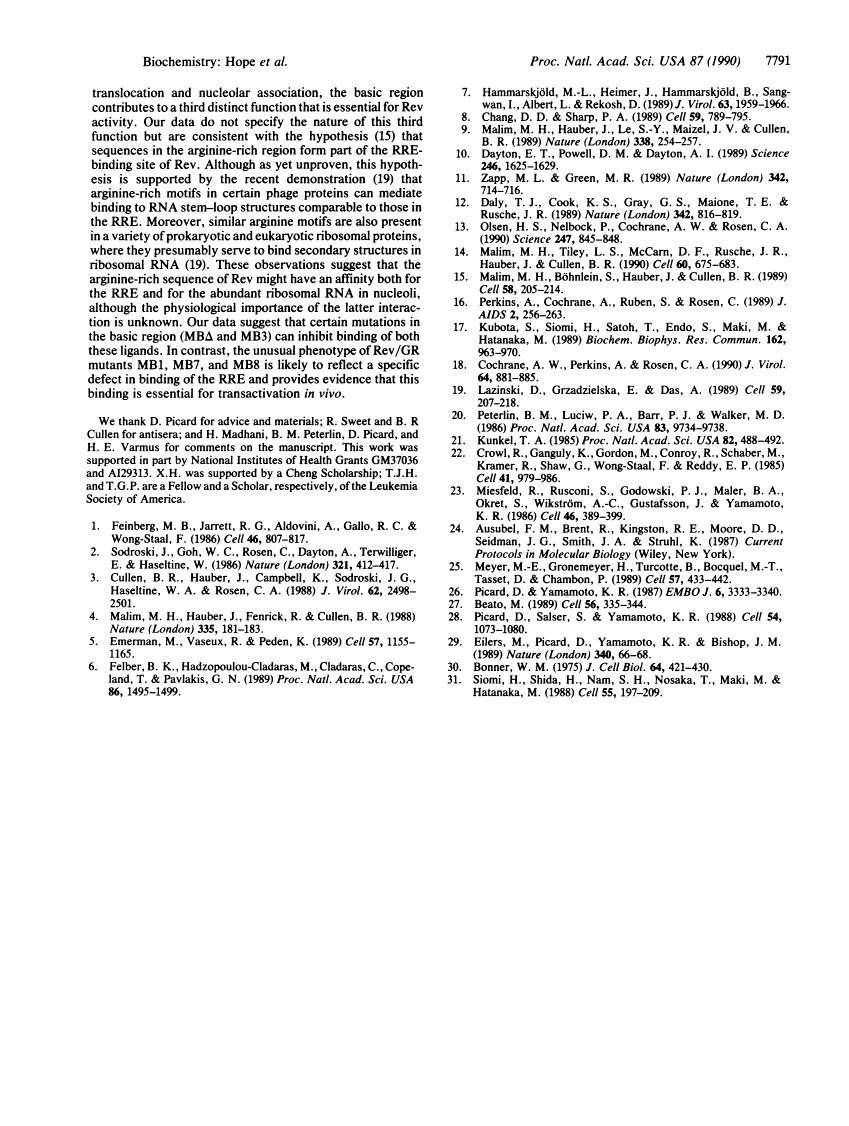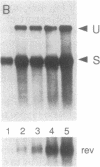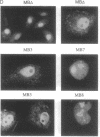Abstract
Free full text

Steroid-receptor fusion of the human immunodeficiency virus type 1 Rev transactivator: mapping cryptic functions of the arginine-rich motif.
Abstract
The human immunodeficiency virus type 1 (HIV-1) transactivator Rev is a nuclear protein that regulates expression of certain HIV-1 transcripts by binding to an RNA target element (the RRE) present in these transcripts. A short arginine-rich sequence in Rev contains the signals required to direct this protein into nuclei, where it associates preferentially with nucleoli. We created a steroid-inducible transactivator by fusing Rev with the steroid-binding domain of the glucocorticoid receptor (GR). This Rev/GR protein remains inactive in the cytoplasm when steroids are absent, but it enters the nucleus and initiates transactivation within minutes after exposure to dexamethasone. Although the GR moiety is sufficient to transport Rev/GR into nuclei, mutation of certain residues in the arginine-rich region blocks nucleolar localization and also inhibits transactivation. We find that other mutations in this region, however, can abolish the function of Rev/GR without affecting its localization; the latter phenotype may reflect a specific defect in binding of the RRE.
Full text
Full text is available as a scanned copy of the original print version. Get a printable copy (PDF file) of the complete article (1.2M), or click on a page image below to browse page by page. Links to PubMed are also available for Selected References.
Images in this article
Click on the image to see a larger version.
Selected References
These references are in PubMed. This may not be the complete list of references from this article.
- Feinberg MB, Jarrett RF, Aldovini A, Gallo RC, Wong-Staal F. HTLV-III expression and production involve complex regulation at the levels of splicing and translation of viral RNA. Cell. 1986 Sep 12;46(6):807–817. [Abstract] [Google Scholar]
- Sodroski J, Goh WC, Rosen C, Dayton A, Terwilliger E, Haseltine W. A second post-transcriptional trans-activator gene required for HTLV-III replication. Nature. 1986 May 22;321(6068):412–417. [Abstract] [Google Scholar]
- Cullen BR, Hauber J, Campbell K, Sodroski JG, Haseltine WA, Rosen CA. Subcellular localization of the human immunodeficiency virus trans-acting art gene product. J Virol. 1988 Jul;62(7):2498–2501. [Europe PMC free article] [Abstract] [Google Scholar]
- Malim MH, Hauber J, Fenrick R, Cullen BR. Immunodeficiency virus rev trans-activator modulates the expression of the viral regulatory genes. Nature. 1988 Sep 8;335(6186):181–183. [Abstract] [Google Scholar]
- Emerman M, Vazeux R, Peden K. The rev gene product of the human immunodeficiency virus affects envelope-specific RNA localization. Cell. 1989 Jun 30;57(7):1155–1165. [Abstract] [Google Scholar]
- Felber BK, Hadzopoulou-Cladaras M, Cladaras C, Copeland T, Pavlakis GN. rev protein of human immunodeficiency virus type 1 affects the stability and transport of the viral mRNA. Proc Natl Acad Sci U S A. 1989 Mar;86(5):1495–1499. [Europe PMC free article] [Abstract] [Google Scholar]
- Hammarskjöld ML, Heimer J, Hammarskjöld B, Sangwan I, Albert L, Rekosh D. Regulation of human immunodeficiency virus env expression by the rev gene product. J Virol. 1989 May;63(5):1959–1966. [Europe PMC free article] [Abstract] [Google Scholar]
- Chang DD, Sharp PA. Regulation by HIV Rev depends upon recognition of splice sites. Cell. 1989 Dec 1;59(5):789–795. [Abstract] [Google Scholar]
- Malim MH, Hauber J, Le SY, Maizel JV, Cullen BR. The HIV-1 rev trans-activator acts through a structured target sequence to activate nuclear export of unspliced viral mRNA. Nature. 1989 Mar 16;338(6212):254–257. [Abstract] [Google Scholar]
- Dayton ET, Powell DM, Dayton AI. Functional analysis of CAR, the target sequence for the Rev protein of HIV-1. Science. 1989 Dec 22;246(4937):1625–1629. [Abstract] [Google Scholar]
- Zapp ML, Green MR. Sequence-specific RNA binding by the HIV-1 Rev protein. Nature. 1989 Dec 7;342(6250):714–716. [Abstract] [Google Scholar]
- Daly TJ, Cook KS, Gray GS, Maione TE, Rusche JR. Specific binding of HIV-1 recombinant Rev protein to the Rev-responsive element in vitro. Nature. 1989 Dec 14;342(6251):816–819. [Abstract] [Google Scholar]
- Olsen HS, Nelbock P, Cochrane AW, Rosen CA. Secondary structure is the major determinant for interaction of HIV rev protein with RNA. Science. 1990 Feb 16;247(4944):845–848. [Abstract] [Google Scholar]
- Malim MH, Tiley LS, McCarn DF, Rusche JR, Hauber J, Cullen BR. HIV-1 structural gene expression requires binding of the Rev trans-activator to its RNA target sequence. Cell. 1990 Feb 23;60(4):675–683. [Abstract] [Google Scholar]
- Malim MH, Böhnlein S, Hauber J, Cullen BR. Functional dissection of the HIV-1 Rev trans-activator--derivation of a trans-dominant repressor of Rev function. Cell. 1989 Jul 14;58(1):205–214. [Abstract] [Google Scholar]
- Perkins A, Cochrane AW, Ruben SM, Rosen CA. Structural and functional characterization of the human immunodeficiency virus rev protein. J Acquir Immune Defic Syndr. 1989;2(3):256–263. [Abstract] [Google Scholar]
- Kubota S, Siomi H, Satoh T, Endo S, Maki M, Hatanaka M. Functional similarity of HIV-I rev and HTLV-I rex proteins: identification of a new nucleolar-targeting signal in rev protein. Biochem Biophys Res Commun. 1989 Aug 15;162(3):963–970. [Abstract] [Google Scholar]
- Cochrane AW, Perkins A, Rosen CA. Identification of sequences important in the nucleolar localization of human immunodeficiency virus Rev: relevance of nucleolar localization to function. J Virol. 1990 Feb;64(2):881–885. [Europe PMC free article] [Abstract] [Google Scholar]
- Lazinski D, Grzadzielska E, Das A. Sequence-specific recognition of RNA hairpins by bacteriophage antiterminators requires a conserved arginine-rich motif. Cell. 1989 Oct 6;59(1):207–218. [Abstract] [Google Scholar]
- Peterlin BM, Luciw PA, Barr PJ, Walker MD. Elevated levels of mRNA can account for the trans-activation of human immunodeficiency virus. Proc Natl Acad Sci U S A. 1986 Dec;83(24):9734–9738. [Europe PMC free article] [Abstract] [Google Scholar]
- Kunkel TA. Rapid and efficient site-specific mutagenesis without phenotypic selection. Proc Natl Acad Sci U S A. 1985 Jan;82(2):488–492. [Europe PMC free article] [Abstract] [Google Scholar]
- Crowl R, Ganguly K, Gordon M, Conroy R, Schaber M, Kramer R, Shaw G, Wong-Staal F, Reddy EP. HTLV-III env gene products synthesized in E. coli are recognized by antibodies present in the sera of AIDS patients. Cell. 1985 Jul;41(3):979–986. [Abstract] [Google Scholar]
- Miesfeld R, Rusconi S, Godowski PJ, Maler BA, Okret S, Wikström AC, Gustafsson JA, Yamamoto KR. Genetic complementation of a glucocorticoid receptor deficiency by expression of cloned receptor cDNA. Cell. 1986 Aug 1;46(3):389–399. [Abstract] [Google Scholar]
- Meyer ME, Gronemeyer H, Turcotte B, Bocquel MT, Tasset D, Chambon P. Steroid hormone receptors compete for factors that mediate their enhancer function. Cell. 1989 May 5;57(3):433–442. [Abstract] [Google Scholar]
- Picard D, Yamamoto KR. Two signals mediate hormone-dependent nuclear localization of the glucocorticoid receptor. EMBO J. 1987 Nov;6(11):3333–3340. [Europe PMC free article] [Abstract] [Google Scholar]
- Beato M. Gene regulation by steroid hormones. Cell. 1989 Feb 10;56(3):335–344. [Abstract] [Google Scholar]
- Picard D, Salser SJ, Yamamoto KR. A movable and regulable inactivation function within the steroid binding domain of the glucocorticoid receptor. Cell. 1988 Sep 23;54(7):1073–1080. [Abstract] [Google Scholar]
- Eilers M, Picard D, Yamamoto KR, Bishop JM. Chimaeras of myc oncoprotein and steroid receptors cause hormone-dependent transformation of cells. Nature. 1989 Jul 6;340(6228):66–68. [Abstract] [Google Scholar]
- Bonner WM. Protein migration into nuclei. I. Frog oocyte nuclei in vivo accumulate microinjected histones, allow entry to small proteins, and exclude large proteins. J Cell Biol. 1975 Feb;64(2):421–430. [Europe PMC free article] [Abstract] [Google Scholar]
- Siomi H, Shida H, Nam SH, Nosaka T, Maki M, Hatanaka M. Sequence requirements for nucleolar localization of human T cell leukemia virus type I pX protein, which regulates viral RNA processing. Cell. 1988 Oct 21;55(2):197–209. [Abstract] [Google Scholar]
Associated Data
Articles from Proceedings of the National Academy of Sciences of the United States of America are provided here courtesy of National Academy of Sciences
Full text links
Read article at publisher's site: https://doi.org/10.1073/pnas.87.19.7787
Read article for free, from open access legal sources, via Unpaywall:
http://www.pnas.org/content/87/19/7787.full.pdf
Citations & impact
Impact metrics
Article citations
Putting a Kink in HIV-1 Particle Infectivity: Rocaglamide Inhibits HIV-1 Replication by Altering Gag-Genomic RNA Interaction.
Viruses, 16(9):1506, 23 Sep 2024
Cited by: 0 articles | PMID: 39339982 | PMCID: PMC11437399
Measurement of HIV Rev-Rev Response Element Functional Activity.
Methods Mol Biol, 2807:175-194, 01 Jan 2024
Cited by: 0 articles | PMID: 38743229
Modulation of HIV-1 gene expression by binding of a ULM motif in the Rev protein to UHM-containing splicing factors.
Nucleic Acids Res, 47(9):4859-4871, 01 May 2019
Cited by: 4 articles | PMID: 30892606 | PMCID: PMC6511859
A novel retroviral vector system to analyze expression from mRNA with retained introns using fluorescent proteins and flow cytometry.
Sci Rep, 9(1):6467, 23 Apr 2019
Cited by: 5 articles | PMID: 31015546 | PMCID: PMC6478720
Highly Mutable Linker Regions Regulate HIV-1 Rev Function and Stability.
Sci Rep, 9(1):5139, 26 Mar 2019
Cited by: 10 articles | PMID: 30914719 | PMCID: PMC6435700
Go to all (174) article citations
Similar Articles
To arrive at the top five similar articles we use a word-weighted algorithm to compare words from the Title and Abstract of each citation.
Exchange of the basic domain of human immunodeficiency virus type 1 Rev for a polyarginine stretch expands the RNA binding specificity, and a minimal arginine cluster is required for optimal RRE RNA binding affinity, nuclear accumulation, and trans-activation.
J Virol, 75(6):2957-2971, 01 Mar 2001
Cited by: 10 articles | PMID: 11222721 | PMCID: PMC115922
Oligomerization and RNA binding domains of the type 1 human immunodeficiency virus Rev protein: a dual function for an arginine-rich binding motif.
Proc Natl Acad Sci U S A, 88(17):7734-7738, 01 Sep 1991
Cited by: 151 articles | PMID: 1715576 | PMCID: PMC52377
HIV-1 structural gene expression requires the binding of multiple Rev monomers to the viral RRE: implications for HIV-1 latency.
Cell, 65(2):241-248, 01 Apr 1991
Cited by: 291 articles | PMID: 2015625
PRMT6 diminishes HIV-1 Rev binding to and export of viral RNA.
Retrovirology, 3:93, 18 Dec 2006
Cited by: 45 articles | PMID: 17176473 | PMCID: PMC1779295
Funding
Funders who supported this work.
NIAID NIH HHS (1)
Grant ID: AI29313
NIGMS NIH HHS (1)
Grant ID: GM37036
